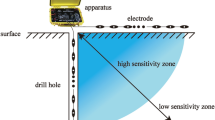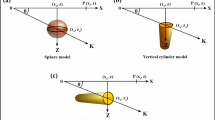Abstract
Geological hazards such as water inrush often occur during tunnel excavation, which always cause economic loss and construction delay. Predicting the water-bearing structures ahead of tunnel face in advance would reduce these risks substantially. Electrical resistivity is considered as an effective technique to detect water-bearing bodies because of its sensitivity to low-resistivity body. However, abnormity of observed data caused by anomalous body below tunnel bottom or behind tunnel wall, called vicinal interference, is always more serious than that ahead of tunnel face. So the first problem is to design one observe configuration to prompt the sensitivity to the anomalous body ahead of tunnel face. A moving electrical-source method (MESM) is proposed in this study, in which source electrodes move along the survey line, and array of measure electrodes are fixed on the tunnel face. Numerical forward modeling examples show that the abnormality degree of MESM data caused by vicinal interference is much lower than that of a traditional observed mode. Electrical resistivity inversion method with inequality constraints is then presented to reduce non-uniqueness and instability. And prior information involving variation range of material resistivity, expressed as a mathematic constraint, is introduced into traditional resistivity inversion equation. Numerical inversion tests are carried out on several geological models and the imaging features, inversion quality and limitation are analyzed and summarized. The test results from both physical model and field experiments the water-bearing body prospecting utilizing MESM has acceptable error and satisfies the accuracy demand in geological ahead prospecting in tunnels.

















Similar content being viewed by others
References
Afshar A, Abedi M, Norouzi GH, Riahi MA (2015) Geophysical investigation of underground water content zones using electrical resistivity tomography and ground penetrating radar: a case study in Hesarak-Karaj, Iran. Eng Geol 196:183–193
Cheng JL, Wang YH, Yu SJ, Li DY (2000) The principle and application of advance surveying in roadway excavation by resistivity method. Coal Geol Explor 28(4):60–62 (in Chinese)
Farrokh E, Rostami J (2009) Effect of adverse geological condition on TBM operation in Ghomroud tunnel conveyance project. Tunn Undergr Space Technol 24(4):436–446
Huang JG, Ruan BY, Wang JL (2007) The fast inversion for advanced detection using DC resistivity in tunnel. Chin J Geophys 50(2):619–624 (in Chinese)
Inazaki T, Isahai H, Kawamura S, Kurahashi T, Hayashi H (1999) Stepwise application of horizontal seismic profiling for tunnel prediction ahead of the face. Lead Edge 18(12):1429–1431
Jetschny S, Bohlen T, Kurzmann A (2011) Seismic prediction of geological structures ahead of the tunnel using tunnel surface waves. Geophys Prospect 59(5):934–946
Kalinski RJ, Kelly WE, Bogardi I, Pesti G (1993) Electrical resistivity measurements to estimate travel times through unsaturated ground water protective layers. J Appl Geophys 30(3):161–173
Kaus A, Boening W (2008) BEAM—geoelectrical ahead monitoring for TBM-drives. Geomech Tunn 1(5):442–450
Li YG, Oldenburg DW (2000) 3-D inversion of induced polarization data. Geophysics 65(6):1931–1945
Li SC, Wu J (2018) Multi-factor comprehensive risk assessment method of karst tunnel and its application. Bull Eng Geol Environ 6:1–16
Li SC, Liu B, Sun HF, Nie LC, Zhong SH, Su MX, Li X, Xu ZH (2014) State of art and trends of advanced geological prediction in tunnel construction. Chin J Rock Mech Eng 33(6):1090–1113 (in Chinese)
Li SC, Liu B, Nie LC, Liu ZY, Tian MZ, Wang SR, Su MX, Guo Q (2015) Detecting and monitoring of water inrush in tunnels and coal mines using direct current resistivity method: a review. J Rock Mech Geotech Eng 7(4):469–478
Li SC, Liu B, Xu XJ, Nie LC, Liu ZY, Song J, Sun HF (2017) An overview of ahead geological prospecting in tunneling. Tunn Undergr Space Technol 63:69–94
Liu SD, Zhang PS, Cao Y, Wang B (2009) Characteristic of geological anomaly detected by combined geophysical methods in a deep laneway of coal mine. Procedia Earth Planet Sci 1(1):936–942
Liu B, Li SC, Nie LC, Wang J, Song J, Liu ZY (2012a) Advanced detection of water-bearing geological structures in tunnels using 3D DC resistivity inversion tomography method. Chin J Geotech Eng 34(10):1866–1876 (in Chinese)
Liu B, Li SC, Nie LC, Wang J, Li LP, Liu ZY, Song J (2012b) Research on simulation of mine water inrush real-time monitoring of using electrical resistivity constrained inversion imaging method. J China Coal Soc 37(10):1722–1731 (in Chinese)
Liu B, Liu ZY, Li SC, Nie LC, Su MX, Sun HF, Fan KR, Zhang XX, Pang YH (2017) Comprehensive surface geophysical investigation of karst caves ahead of the tunnel face: a case study in the Xiaoheyan section of the Water Supply Project from Songhua River, Jilin, China. J Appl Geophys 144:37–49
Otto R, Button E, Bretterebner H, Schwab P (2002) The application of TRT-true reflection tomography-at the unterwald tunnel. Felsbau 20(2):51–56
Park J, Lee KH, Park J, Choi H, Lee IM (2016) Predicting anomalous zone ahead of tunnel face utilizing electrical resistivity: I. Algorithm and measuring system development. Tunn Undergr Space Technol 60:141–150
Petronio L, Poletto F, Schleifer A (2007) Interface prediction ahead of the excavation front by the tunnel-seismic-while-drilling (TSWD) method. Geophysics 72(4):39–44
Sattel G, Sander BK, Amberg F, Kashiwa T (1996) Tunnel seismic prediction TSP-some case histories. Tunn Tunn 4:24–30
Saunders MA (1996) Cholesky-based methods for sparse least squares: the benefits of regularization. Linear Nonlinear Conj Gradient Relat Methods 100:95–100
Turesson A (2006) Water content and porosity estimated from ground-penetrating radar and resistivity. J Appl Geophys 58(2):99–111
Wu J, Li SC, Xu ZH, Huang X, Xue YG, Wang ZC, Li LP (2017) Flow characteristics and escape-route optimization after water Inrush in a backward–excavated karst tunnel. Int J Geomech 17(4):1–16. 04016096
Xue GQ, Yan YJ, Li X, Di QY (2007) Transient electromagnetic S-inversion in tunnel prediction. Geophys Res Lett. https://doi.org/10.1029/2007gl031080
Yadav GS, Singh SK (2007) Integrated resistivity surveys for delineation of fractures for ground water exploration in hard rock areas. J Appl Geophys 62(3):301–312
Yamamoto T, Shirasagi S, Yokota Y, Koizumi Y (2011) Imaging geological conditions ahead of a tunnel face using three-dimensional seismic reflector tracing system. Int J JCRM 6(1):23–31
Acknowledgements
This paper is supported by the National Program on Key Basic Research Project of China (973 Program) (Nos. 2015CB058101, 2014CB046901), National Key Scientific Instrument and Equipment Development Project (No. 51327802), National Natural Science Foundation of China (Nos. 51739007, 41502279), The National Key Research and Development Plan of China (Nos. 2016YFC0801604, 2016YFC0401801), The Royal Academy of Engineering under the UK-China Industry Academia Partnership Programme Scheme (No. UK-CIAPP\314), Fundamental Research Funds of Shandong University (No. 2014QY007). These supports are greatly acknowledged.
Author information
Authors and Affiliations
Corresponding author
Rights and permissions
About this article
Cite this article
Guo, Q., Nie, L., Li, N. et al. Water-Bearing Body Prospecting Ahead of Tunnel Face Using Moving Electrical-Source Method. Geotech Geol Eng 37, 2047–2064 (2019). https://doi.org/10.1007/s10706-018-0743-0
Received:
Accepted:
Published:
Issue Date:
DOI: https://doi.org/10.1007/s10706-018-0743-0




